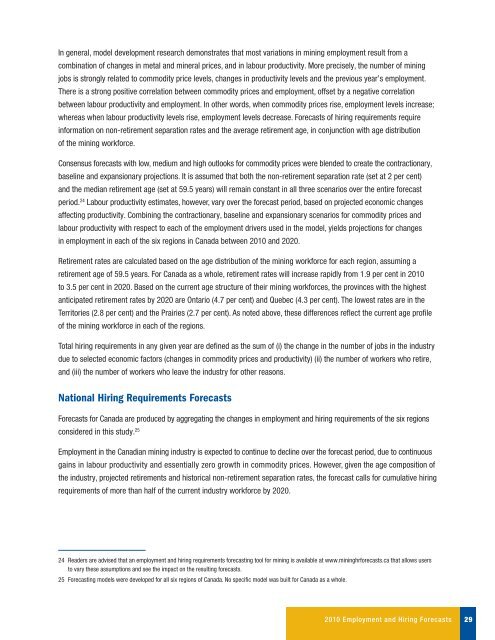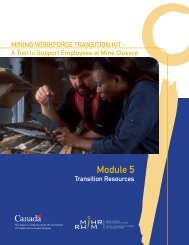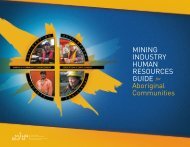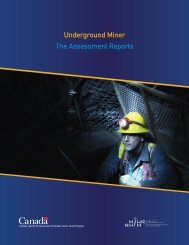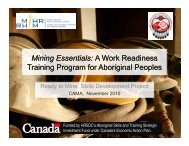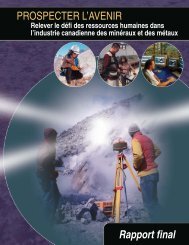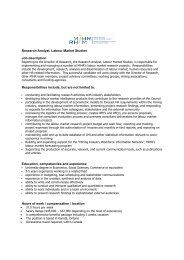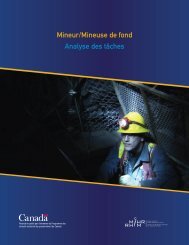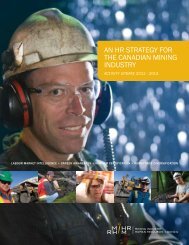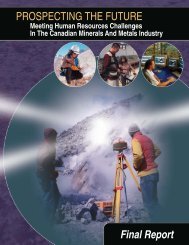Canadian Mining Industry Employment and Hiring Forecasts - MiHR
Canadian Mining Industry Employment and Hiring Forecasts - MiHR
Canadian Mining Industry Employment and Hiring Forecasts - MiHR
Create successful ePaper yourself
Turn your PDF publications into a flip-book with our unique Google optimized e-Paper software.
In general, model development research demonstrates that most variations in mining employment result from a<br />
combination of changes in metal <strong>and</strong> mineral prices, <strong>and</strong> in labour productivity. More precisely, the number of mining<br />
jobs is strongly related to commodity price levels, changes in productivity levels <strong>and</strong> the previous year’s employment.<br />
There is a strong positive correlation between commodity prices <strong>and</strong> employment, offset by a negative correlation<br />
between labour productivity <strong>and</strong> employment. In other words, when commodity prices rise, employment levels increase;<br />
whereas when labour productivity levels rise, employment levels decrease. <strong>Forecasts</strong> of hiring requirements require<br />
information on non-retirement separation rates <strong>and</strong> the average retirement age, in conjunction with age distribution<br />
of the mining workforce.<br />
Consensus forecasts with low, medium <strong>and</strong> high outlooks for commodity prices were blended to create the contractionary,<br />
baseline <strong>and</strong> expansionary projections. It is assumed that both the non-retirement separation rate (set at 2 per cent)<br />
<strong>and</strong> the median retirement age (set at 59.5 years) will remain constant in all three scenarios over the entire forecast<br />
period. 24 Labour productivity estimates, however, vary over the forecast period, based on projected economic changes<br />
affecting productivity. Combining the contractionary, baseline <strong>and</strong> expansionary scenarios for commodity prices <strong>and</strong><br />
labour productivity with respect to each of the employment drivers used in the model, yields projections for changes<br />
in employment in each of the six regions in Canada between 2010 <strong>and</strong> 2020.<br />
Retirement rates are calculated based on the age distribution of the mining workforce for each region, assuming a<br />
retirement age of 59.5 years. For Canada as a whole, retirement rates will increase rapidly from 1.9 per cent in 2010<br />
to 3.5 per cent in 2020. Based on the current age structure of their mining workforces, the provinces with the highest<br />
anticipated retirement rates by 2020 are Ontario (4.7 per cent) <strong>and</strong> Quebec (4.3 per cent). The lowest rates are in the<br />
Territories (2.8 per cent) <strong>and</strong> the Prairies (2.7 per cent). As noted above, these differences reflect the current age profile<br />
of the mining workforce in each of the regions.<br />
Total hiring requirements in any given year are defined as the sum of (i) the change in the number of jobs in the industry<br />
due to selected economic factors (changes in commodity prices <strong>and</strong> productivity) (ii) the number of workers who retire,<br />
<strong>and</strong> (iii) the number of workers who leave the industry for other reasons.<br />
National <strong>Hiring</strong> Requirements <strong>Forecasts</strong><br />
<strong>Forecasts</strong> for Canada are produced by aggregating the changes in employment <strong>and</strong> hiring requirements of the six regions<br />
considered in this study. 25<br />
<strong>Employment</strong> in the <strong>Canadian</strong> mining industry is expected to continue to decline over the forecast period, due to continuous<br />
gains in labour productivity <strong>and</strong> essentially zero growth in commodity prices. However, given the age composition of<br />
the industry, projected retirements <strong>and</strong> historical non-retirement separation rates, the forecast calls for cumulative hiring<br />
requirements of more than half of the current industry workforce by 2020.<br />
24 Readers are advised that an employment <strong>and</strong> hiring requirements forecasting tool for mining is available at www.mininghrforecasts.ca that allows users<br />
to vary these assumptions <strong>and</strong> see the impact on the resulting forecasts.<br />
25 Forecasting models were developed for all six regions of Canada. No specific model was built for Canada as a whole.<br />
2010 <strong>Employment</strong> <strong>and</strong> <strong>Hiring</strong> <strong>Forecasts</strong><br />
29


